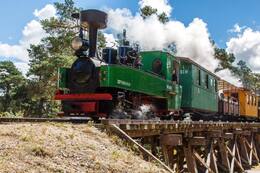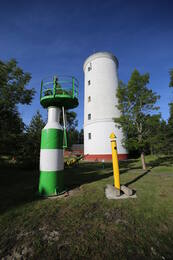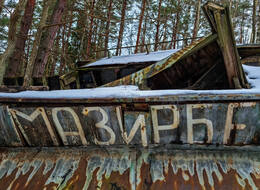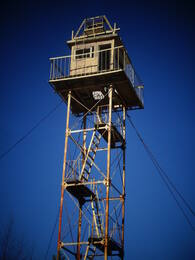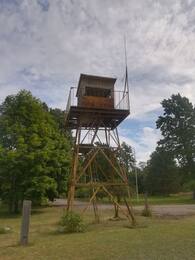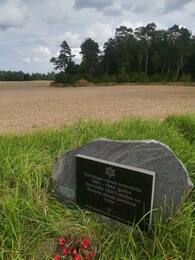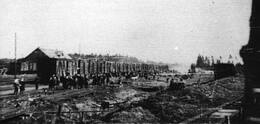The important place of Stendes station in the railway network of the kingdom
The main task of the royal railways in the area of the Partridge Strait was to provide the coastal defense positions of the German army with cannons and ammunition.
These royal railways, built exclusively for military purposes, connect the three most important lighthouses located in Oviši, Miķeļtornī and Šlītere.
The railway line Ventspils - Mazirbe, as well as the extension of Stende - Dundaga to Mazirbe with a branch to Pitrag were intended only for military strategic needs. During the construction of these lines and also later, all civilians were evacuated from this region. However, despite this, passenger transportation was also provided during the years of the 1st World War.
Toms Altbergs, Andris Biedriņš, Dainis Punculs, Artūrs Tukišs "RURAL WIDE RAILWAYS" Mazbānītis de facto
Related timeline
Related objects
Narrow gauge railway train “Mazbānītis” in Ventspils Seaside Open-air museum
In the Seaside Open-Air Museum in Ventspils you can take a ride on two narrow-gauge railway lines with the train ‘Mazbānītis’. The Circle line is 1.4 km and the Mountain line is 3 km. ‘Mazbānītis’ is the locomotive that transported passengers and cargo on 600 mm narrow-gauge railway tracks between 1916 and 1963. It is a legacy of military history from World War I that once played an important role in the cultural and economic development of northern Kurzeme by connecting settlements and providing new jobs.
Construction of a large 600 mm narrow-gauge railway network is largely associated with World War I, when the German Army in 1916 started the construction of several so-called military field railways (Heeresfeldbahn in German) in the occupied territory of Latvia. These railways could be quickly constructed, deconstructed and moved to another front line. The Latvian narrow-gauge railway network was used also during World War II. For almost 60 years the narrow-gauge railway was the only safe way of transporting passengers, various agricultural products and timber to cities in both winter and summer.
Mazbānīš trail in North Kurzeme
Mazbānīti is the name given to a train in North Kurzeme that transported passengers and cargo along 600 mm wide narrow-gauge railway tracks between 1916 and 1963. It is a legacy of military history from the First World War, which once played an important role in the cultural and economic prosperity of the whole of Northern Kurzeme, but especially of the Libyan fishing villages, providing connections between settlements, providing jobs.
The nature trail leads from Mazirbe to Sīkraga along the path of the former Stende - Ventspils narrow-gauge railway, or as the locals say - the path of Mazbānīš. The construction of the railway started in 1916 and it served until 1963. The narrow-gauge railway line connected the port city of Ventspils with the coastal fishing villages of Dundas and the major railway hub of Stande, thus contributing to the region's economic and cultural boom between the First and Second World Wars.
During the times of the Soviet Union, the coast was a "Closed Zone", therefore coastal villages were economically isolated and their population decreased, the presence of newly built secret army facilities also contributed to the fact that in the sixties of the last century, railway traffic was stopped.
The trail has a small loop of 15 km and a large loop of 19 km.
The GPX map is available here:
https://www.kurzemesregions.lv/projekti/turisms/unigreen/dabas-takas/mazbanisa-dabas-taka/
Oviši Lighthouse and Soviet border guard
Oviši Lighthouse is located in the Tārgale parish in a village called Oviši on the coast of Kurzeme. It was built in 1814 and it is the oldest lighthouse in Latvia. The height of Oviši Lighthouse tower is 37 m. The lighthouse has a double-cylinder design: its diameter is 11.5 m, but within the stone wall there is a second tower with a diameter of 3.5 m. Such double-cylinder lighthouses were used also as defensive structures in the 18th-19th century Europe in case of enemy attacks. The Oviši Lighthouse Museum is considered to have the largest collection of lighthouse equipment and maritime navigation items among all Latvian lighthouse museums. When the weather is right the Irbe Lighthouse can be seen from Oviši Lighthouse.
At the end of World War II, the headquarters of the Beminger Battalion of the German Army was located near the Oviši Lighthouse along with the 4th Battery of the 530th Naval Artillery Division with several anti-aircraft guns. It is said that there was a radio direction finder and an infrared ray detection station Donau Gerät located at the foot of the lighthouse. A Soviet border guard post was once located near the lighthouse, but none of the Soviet-era buildings have survived. The Oviši station building is still located in the territory of the lighthouse.
Mazirbe boat cemetery
Mazirbe, historically known as the largest Liv centre, is notable for the only fishermen's boat cemetery on the Latvian coast. It was built in the 1960s, the last boats were brought in 1976. The boats ended up here as a result of both fishing restrictions and age.
Today, Mazirbe has less than ten wrecks of fishing boats, but historically there have been many more. Boats have been laid to rest in other seaside villages, but it is in Mazirbe's boat graveyard that this is most evident today.
The Mazirbe Boat Cemetery is the only one of its kind on the Latvian coast.
Mazirbe border guard tower
The Soviet border defence post was located in the building that used to be a maritime school, and next to it is a well-preserved Soviet border guard watchtower. The second watchtower is located right on the shore next to a parking lot. These watchtowers are a reminder of the Soviet occupation and the times when Mazirbe was a closed border area and civilians were allowed on the shore only in specially designated places and only during the daytime. This border guard watchtower is one of the best-preserved objects of its type on the coast of Latvia. However, it designated is dangerous to climb it.
Mazirbe Nautical School
The Soviet Border Guard Tower in this complex is one of the best preserved of its kind on the Latvian coast. Unfortunately, the condition of the buildings is poor, there is a rifle loading/unloading site on the site, and a drive and fragments of trenches have been salvaged.
The Coast Guard post was located in the former Marine School building. In the post-Soviet period, accommodation was offered in parts of the buildings.
The second tower of the Soviet Border Guard is located about 400 m from the beach, but unfortunately it is in a state of disrepair. However, the Mazirbe boat cemetery is located not more than 500 m from the beach tower towards Sīkrags.
Stende railway station in narrow gauge railway network and the memorial stone for deportations
The railway line Ventspils - Mazirbe, as well as the Stende - Dundaga extension to Mazirbe with a branch to Pitrags, were intended only for strategic military needs. During the construction of these lines, and afterwards, all civilians were evacuated from the region. The main task of the military railways in the Irbe Strait area was to provide the German army's coastal defence positions with guns and ammunition.
These military-only military railways also connected the three most important lighthouses, located in Oviši, Mikeltornis and Šlītere.
Nevertheless, passenger transport was also provided as early as the years of World War I.
A memorial stone (1989) to the deported Latvians of 1941 and 1949 is located at the Stende railway station.
On 30 October 1919, Stende railway station was occupied by Bermont troops. On 17 November, soldiers of the Latvian army led by K. Šnēbergs attacked the station, driving away a wagon with weapons, war materials and grain. 6 soldiers were awarded the Order of the Order for these battles: K. Bumovskis (1891-1976), P. Strautiņš (1883-1969), R. Plotnieks (1891-1965), E. Jansons (1894-1977).






